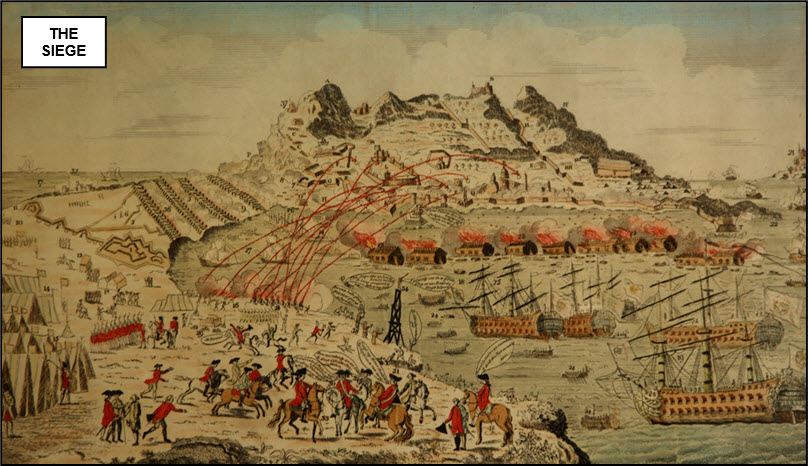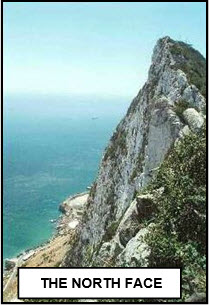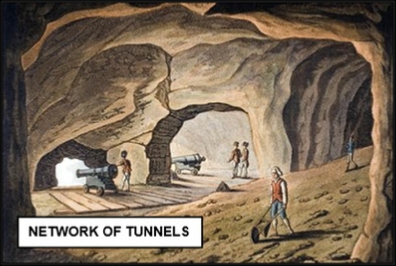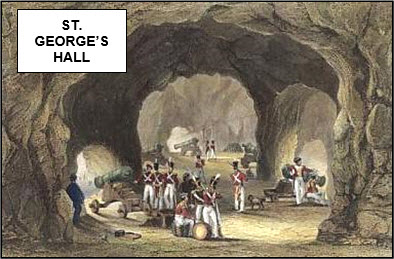


THE GREAT SIEGE OF GIBRALTAR 1779 -
xxxxxAs we have seen, Gibraltar was captured by the British in 1704 (AN). Over the years, the Spanish made a number of unsuccessful attempts to regain the “Rock”", and then in 1779, allied with the French, began the Great Siege, not lifted until 1783. The British were seriously outnumbered, but despite heavy bombardment, an attack by fire ships, and concentrated fire from floating gun platforms, the defences could not be breached. During the siege British engineers tunnelled into the Rock itself, and established gun emplacements at a number of vantage points. This increase in firepower proved significant. Having failed again, this was the last attempt by the Spanish to regain the fortress by force of arms.

XxxxxAs we have seen, Gibraltar was attacked and captured by an English fleet under the command of Admiral Sir George Rooke in July 1704 (AN). By the Treaty of Utrecht of 1713 which ended the War of the Spanish Succession, the “Rock”, as it came to be called, was ceded to the British. The Treaty made it clear that “the town, castle and fortifications were to be held and enjoyed for ever without any exception or impediment whatsoever”. It was to prove a rock indeed in the history of British sea power, and, not surprisingly, the treaty was renewed in the Treaty of Paris of 1763, and again twenty years later.
xxxxxThe years that followed the Treaty of Utrecht witnessed a dozen attempts by the Spanish to recapture the rugged peninsular on their southern coastline, but the natural fortress proved easier to defend than to attack. There was a particularly serious attempt in 1727, but the last, longest and most promising siege of Gibraltar came in 1779. With the French having the previous year come out in open support of the American colonists in their fight against the British, the Spanish now saw a golden opportunity to recapture their spit of highly valuable land.

xxxxxKnown for obvious reasons as the “Great Siege”, it lasted from July 1779 to February 1783, and caused a great deal of destruction to the town and its fortifications. A combined Spanish and French force launched a massive, all-
xxxxxBut perhaps the major contribution to the survival of the rock fortress in this particular siege was the valuable improvement made to the garrison's fire power, an improvement which came about almost by chance. In 1782 the governor of Gibraltar, General Eliott, an outstanding leader, offered a reward to any member of his staff who could work out a way of getting a gun onto a small promontory called the  ”Notch” on the steep northern face of the Rock. Attempts were made to hoist up an artillery piece, but the task proved too difficult. AxSergeant Major Ince then came up with the idea of tunneling through the Rock to reach the vantage point. The “tunnelers”, with sledge hammers and crowbars and the occasional use of gunpowder, set to work in May 1782.
”Notch” on the steep northern face of the Rock. Attempts were made to hoist up an artillery piece, but the task proved too difficult. AxSergeant Major Ince then came up with the idea of tunneling through the Rock to reach the vantage point. The “tunnelers”, with sledge hammers and crowbars and the occasional use of gunpowder, set to work in May 1782.
xxxxxIn five weeks 18 men had cut an 82 foot tunnel into the Rock, but as they went deeper towards the Notch they could hardly breath because of the dust from the digging and the fumes from the blasting. It was decided that a side tunnel had to be made to reach the face of the Rock and let in more air. This they did, and then quickly realized that by making the air vent larger they would have, in fact, the perfect gun emplacement! By the time the siege ended the tunnel -
xxxxxThe Rock’s ingenious defence system did not come a moment too soon. By September of 1782, the Spanish and French had come to the conclusion that a heavy bombardment was needed before troops attacked by sea and land. They converted a number of double-
 xxxxxInxrecognition of his gallant leadership, General George Augustus Eliott (1717-
xxxxxInxrecognition of his gallant leadership, General George Augustus Eliott (1717-
 xxxxxIncidentally, after the Battle of Trafalgar in 1805, the body of Admiral Horatio Nelson -
xxxxxIncidentally, after the Battle of Trafalgar in 1805, the body of Admiral Horatio Nelson -
xxxxx...... Legend has it that if the Barbary apes (actually monkeys) who live on the Rock were to die off that would mark the end of British rule. It is rumoured that during the Second World War the British prime minister, Winston Churchill, had more apes brought over from North Africa just in case! ......
xxxxx…… Gibraltar has suffered so many sieges over the years that the toast “to the siege of Gibraltar” is considered a valid excuse to have a drink at any time!
Acknowledgements
Siege: printed and published by the French partnership of Esnauts et Rapilly. North Face: date and photographer unknown. Tunnels: by the English artist the Rev. Cooper Willyams (1762-
G3a-


